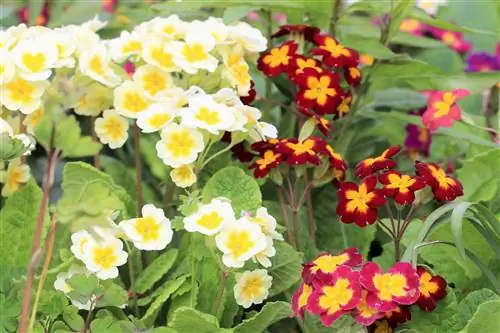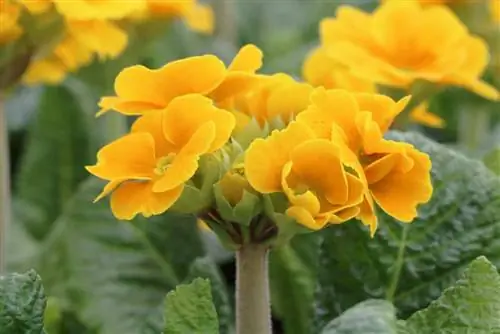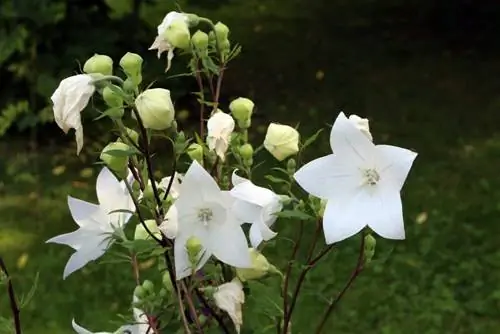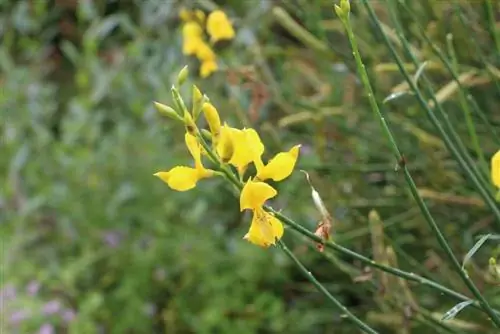- Author admin [email protected].
- Public 2023-12-17 03:39.
- Last modified 2025-01-24 12:45.
Primrose is the generic term for a genus of plants that has around 500 species. They are one of the most popular flowering plants and can grow and thrive indoors as well as outdoors. In order to be able to enjoy these popular plants for several years, it is important that they are cared for properly and that propagation and overwintering are carried out correctly.
Care
Depending on the primrose species, the care can vary slightly depending on the location. The aim here is to create the best possible conditions. This is particularly important if you want the primroses to bring joy for several years.
Tip:
Since the ideal conditions are difficult to implement, you should generally look for a cool room for the flowering period. After flowering, the plants can be planted in the garden or placed completely in a pot.
Popular primrose varieties
Cup Primrose
The cup primrose prefers it to be quite bright. A bright location, but without direct sunlight, is therefore best suited. The temperatures should be around 15 °C and relatively constant. Even over the winter months, the cup primrose can grow and thrive well under such conditions. Watering should take place regularly. It is important that the soil does not dry out, but also that no waterlogging forms, which could lead to mold.
Lilac Primrose
The lilac primrose, on the other hand, prefers a partially shaded location that is also airy but only moderately warm. The optimal air temperature is between 10 °C and 15 °C. Since this may be difficult to implement, especially in the summer months, the flowers may not be as magnificent. The pot ball of the lilac primrose must be kept evenly moist so that the plant can draw sufficient water. Regular watering is therefore important. Here too, care must be taken to ensure that no waterlogging can form. Excess liquid could, for example, be collected in a planter or saucer and then disposed of.
Cushion Primrose
Last but not least, the primrose cushions: They prefer a bright location. Preferably on the windowsill, where there may be direct sunlight. In terms of temperature, the Primrose cushion likes it very cool. It feels most comfortable at temperatures between 5 °C and 10 °C. The primrose cushion also requires sufficient water, which must not accumulate. The earth must not dry out. This applies not only to the cushion primroses that are grown indoors, but also to all those that move into the garden after flowering.
Propagation
Propagation is possible by:
- Self-sowing plants in the garden
- targeted sowing in seed boxes
Primroses usually reproduce by self-sowing. If the plants are in the garden, you hardly have to worry about new plants. Because when the plants are in full bloom and the wind blows a little, the seeds will fall out and ensure a sufficient supply of beautiful plants. The best new primroses can be grown when the soil is relatively clayey. This way the seeds don't fly away too quickly and the soil is usually quite moist due to the clay. Optimal conditions for good growth are therefore always present.
If you don't want a wide spread in the garden, you can also use seed boxes. The primrose seeds can be placed into this and the reproduction takes place in a regulated manner. The seed should be covered with a small layer of soil or sand. 5 mm is completely sufficient. Here too, sufficient moisture is fundamentally important. After sowing, the seed boxes are closed with a bag or foil to create a closed space. The boxes can then be left outside until the seeds have sprouted and the first tender plants appear. These then need to be planted apart so that each plant has enough space to grow.
Tip:
If propagation seems too time-consuming, you can skip this step. Primroses are quite inexpensive plants, so purchasing them as a finished, flowering plant is quite easy and involves little cost.
Wintering
Primroses are undemanding plants and are therefore quite easy to care for and overwinter. If they bloom in spring, then a location in a room is always a good choice. This way the full splendor of the small flowers can unfold and you can really enjoy them. After flowering, the plants should be moved outdoors. They can also be kept in pots there. But they also like a place on the border where their roots can spread particularly well. In autumn, when the first night frosts are just around the corner, the primroses should be brought back into the warm to prevent the plants from freezing. For optimal overwintering, the room in which the primroses can overwinter should be light, airy and cool. Watering should only be done every now and then to prevent the soil from drying out.
Tip:
If the winter is not too severe, the primroses can also overwinter in the garden. Then it is sufficient if the plants are covered with a little straw or leaves. They are not very demanding in this regard.
Frequently asked questions
When do primroses usually bloom?
In contrast to many other flowering plants, primroses are early bloomers that prefer the cool temperatures in spring for their full bloom. The early bloomers are therefore often used alongside the pansies to bring the first fresh greenery into the garden and to bridge the time until the other flowers such as roses begin to bloom.
When is it worth propagating?
Propagation is only worthwhile if you want a lot of primroses. If you only want the plants to provide a little color on the windowsill, you are usually better off buying a few flower pots with primroses that have already bloomed. The costs are low and would not do justice to the effort involved in propagating your own.
How many types of primroses are there?
Currently around 500 species are known. The Primrose cushions, the Primrose lilacs and the Primrose mugs are particularly popular. If you like something a little more exotic, you should ask a specialist retailer or actually grow it yourself.
What you should know about primroses in brief
Profile
- Primroses are popular spring bloomers. There are several hundred species and countless varieties and hybrids. The color spectrum of the flowers is enormous.
- Garden primroses are hardy, but some species are sensitive and require winter protection.
- Popular garden primroses are the high cowslip, lilac primroses, cushion primroses, ball primroses, floor primroses and many others.
- Most primroses are suitable for naturalization, they are undemanding and easy to care for.
- You can also cultivate primroses in your home and bring a little spring into your own four walls.
Care and plants
- Most primroses like a sunny to partially shaded location. But you shouldn't plant them in the blazing midday sun.
- Primroses require fresh, moisture-retaining and nutrient-rich soil.
- Primroses from mountainous areas, on the other hand, need more permeable soil. A drainage layer, for example made of gravel, works well for them.
- When planting primroses, you should incorporate a lot of compost.
- Primroses in the apartment also like a bright location and temperatures between 15 and 20 °C.
- If you put them in the warm living room, they usually wither pretty quickly.
- To preserve the flowers for a long time, it is best to keep them a little cooler.
- With primroses on the window frame, you should make sure that they are not in the midday sun.
- Primroses in flower pots must always be kept slightly moist, but not wet. Waterlogging must be avoided at all costs.
- After the first flowering, they are planted in the garden. Pre-grown specimens from garden centers and discount stores should not be planted out too early.
- Once the plants have settled into the garden, you can enjoy them for many years.
Wintering
- Primroses in the garden overwinter without any problems. Some, somewhat sensitive species can be covered with leaves or brushwood. Otherwise they are undemanding.
- It's usually not worth overwintering primroses in flower pots. The plants are so inexpensive that they are usually thrown away when they have finished flowering.
- If you want to overwinter it, keep it cool but bright, water it little, always just enough so that the soil doesn't dry out.
Propagate
- Primroses reproduce easily by self-sowing. So you don't have to worry about the garden primroses.
- This sowing works best in loamy soil. Otherwise, you can also sow primroses in seed boxes.
- The cold germinator primroses are planted in seed soil from November to February.
- The seeds are covered with sand about three millimeters thick.
- Then everything is moistened well.
- The seed boxes are closed, with a lid or a transparent plastic bag and placed outside at temperatures between 10 and 15 °C.
- The seeds germinate at 10 to 12 °C by May at the latest. Then the lid or bag can also be removed.
Tip:
Primroses can also be propagated by root cuttings. For this to happen, the plant must have very strong roots. You divide them and plant them again separately.






